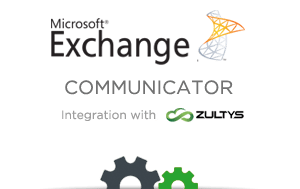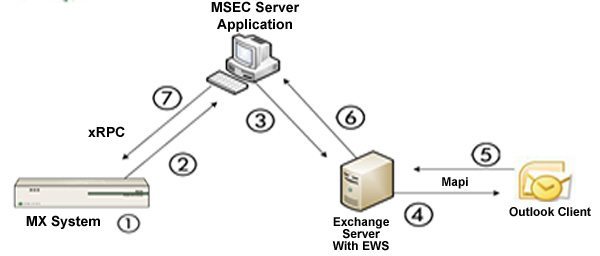
Microsoft Exchange Communicator™Boost Agent Productivity with Integrated Call Controls Within Microsoft Exchange

MS Exchange® integration via MS Exchange Communicator (MSEC) allows MX users to have their voice mails and faxes automatically delivered and synchronized to their email client on Windows based PCs. When a user reads or deletes the email message on their PC, the voice mail / fax message state on the MX system will reflect the change.
MSEC 2.0 and later supports integration with MS Exchange 2010 SP1 and later, as well as MS Exchange Online. The MSEC application must be installed on a host PC running Windows XP Pro or later (machine must be able to join Domain). The MX system must be running Release 9.0 or later.
Unified Messaging with MSEC and Exchange Server
Unified Messaging (UM) provides the ability for users to receive their voice mails, faxes, and emails in a single email client. The MX-SE, MX250 and MXvirtual unified communication systems have integrated voice mail and fax server capabilities. The MS Exchange Communicator (MSEC) software establishes a communication path between the MX system and an MS Exchange Server to provide bi-directional synchronization of received user voice mail and fax messages.

Event Sequence for Delivery of Messages
When a new voice mail message or fax is received (marked 1 in the above diagram) the MX system sends a proprietary xRPC message over IP to the MSEC application along with the voice mail or fax file (marked 2). An EWS (Exchange Web Services) message is then sent by the MSEC application to the Microsoft Exchange server along with that voice mail or fax file (marked 3). Microsoft Exchange formulates a message with the voice mail or fax as an attachment and delivers that message to the appropriate user’s Exchange mailbox. Microsoft Exchange then delivers the message to the user’s Outlook client using MAPI (marked 4).
Synchronized Mailboxes
If a voice mail message or a fax is reviewed in MS Outlook and then subsequently saved or deleted in Outlook, this action is synchronized with the MX mailbox so that the message is also marked as saved in or deleted from the user’s mailbox on the MX system. The Outlook client will send a MAPI message to the Exchange server (marked 5). The Exchange server will then send an EWS message to the MSEC application with the notification that the message was read or deleted (marked 6). The MSEC application sends an xRPC message to the MX system with the notification to mark the message as read or deleted (marked 7). If a voice mail or fax is saved or deleted using the MXIE user interface, the change is synchronized with the Exchange mailbox and the associated email messages in the Outlook client will be marked as read or deleted as described previously. If a voice mail message on the MX system is reviewed or deleted using the phone, the changes are synchronized with the Exchange mailbox and the associated email messages are marked as read or deleted as described previously.
The True All-In-One Contact Center
Whether your organization is in the Public or Private Sector, Zultys’ feature-rich Unified Communications solution will supercharge your Contact Center by increasing efficiency, productivity & customer support.

